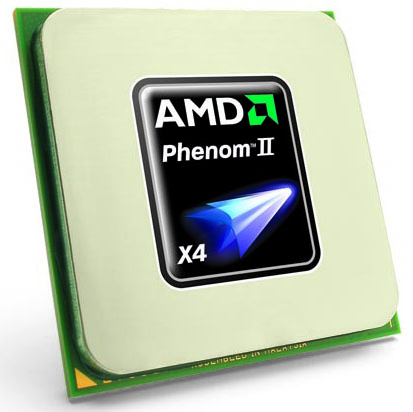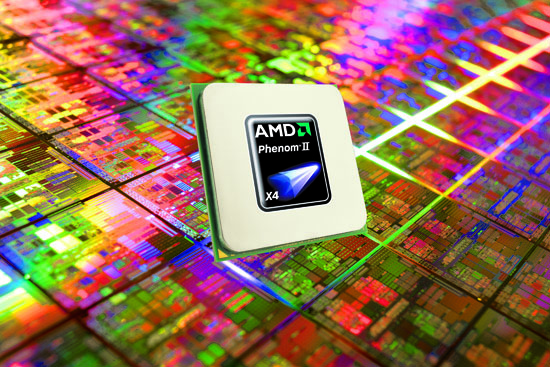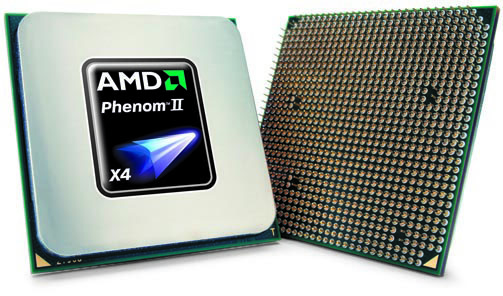|
AMD Phenom II X4 955 Black Edition Processor


The battle between AMD versus
Intel has reached the next level with AMD's latest Phenom II
CPU's just hitting the market which promises additional power for not
only general PC users but also those seeking the Dragon Platform.
For those unaware of the Dragon Platform,
it's for gamers who want the best and when this CPU is matched with one
of the Radeon HD 4800 series of graphics cards, the combination of CPU
and Graphics power truly goes into high gear which offers some truly
remarkable results.

Best of all, the AMD Phenom II X4 955
is faster, more powerful and is still one of the most affordable
processors available today. AMD should also be commended on their backward
compatibility as the Phenom II X4 CPU can be used on both AM2 and
AM3 motherboards and is compatible with both DDR2 and DDR3 RAM.
This is a huge edge for AMD, unlike their
competitors that usually require motherboard upgrades for almost all
their new CPU's. However for ultimate performance, an AM3 mother board
and DDR3 RAM is preferred and users should always check with their
motherboard manufactures, whether their board will support the new
Phenom II.

The CPU is based on
AMD's new 45nm manufacturing technology that has around 758 million
transistors, contains four processors and has a speed of 3.2Ghz. For the
"techno" purists, the specifications of the processor is as follows;
NEW Phenom™ II X4 Processor Specifications
-
Model Number & Core
Frequency: X4 955 Black Edition = 3.2GHz
-
X4 955 Black Edition
OPN: TRAY OPN# HDZ955FBK4DGI
-
X4 955 Black Edition
OPN: PIB OPN# HDZ955FBGIBOX
-
L1 Cache Sizes: 64K
of L1 instruction and 64K of L1 data cache per core (512KB total L1
per processor)
-
L2 Cache Sizes:
512KB of L2 data cache per core (2MB total L2 per processor)
-
L3 Cache Size: 6MB
(shared)
-
Total Cache (L2+L3):
8MB
-
Memory Controller
Type: Integrated 128-bit wide memory controller *
-
Memory Controller
Speed: Up to 2.0GHz with Dual Dynamic Power Management
-
Types of Memory
Supported: Unregistered DIMMs up to PC2-8500 (DDR2-1066MHz) -AND-
PC3-10600 (DDR3-1333MHz)
-
HyperTransport 3.0
Specification: One 16-bit/16-bit link @ up to 4.0GHz full duplex
(2.0GHz x2)
-
Total
Processor-to-System Bandwidth: Up to 37.3GB/s total bandwidth [Up to
21.3 GB/s memory bandwidth (DDR3-1333) + 16.0GB/s (HT3)]
-
Up to 33.1GB/s total
bandwidth [Up to 17.1 GB/s memory bandwidth (DDR2-1066) + 16.0GB/s
(HT3)]
-
Packaging: Socket
AM3 938-pin organic micro pin grid array (micro-PGA)
-
Fab location:
GLOBALFOUNDARIES Fab 1 module 1 in Dresden, Germany (formerly AMD
Fab 36)
-
Process Technology:
45-nanometer DSL SOI (silicon-on-insulator) technology
-
Approximate Die
Size: 258 mm2
-
Approximate
Transistor count: ~ 758 million
-
Max Temp: 62o
Celsius
-
Nominal Voltage:
0.875-1.5V
-
Max TDP: 125 Watts
*Notes:
Black Edition processors support software-selectable increases to memory
controller, HyperTransport, DDR3 and CPU core frequency MC configurable
for dual 64-bit channels for simultaneous read/writes.
For DDR3-1333, AMD Phenom II supports 1-DIMM-per-channel @ 1333MHz
Needless to say, the Phenom II X4 955 is a beast in terms of
power and performance, however where the processor does shine is through
the ability to overclock the CPU and we at Impulse Gamer decided to push
the clock speed with some appropriate cooling measures. With that said,
we managed to successfully overclock the CPU to 3.8Ghz.
Impressive as it may
sound, AMD are the ones responsible behind their over-clocking tool, the
"AMD OverDrive Utility" version 3.0 and in conjunction with their
Advanced Clock Calibration technology, this allows for some great
tweaking.
Just be warned though that if you are interested in
overclocking, you will need to purchase the Black Edition of the CPU as
the regular Phenom II processor has the multiplier locked.

Testing done by other users around the
world have managed to push the CPU to reach stable speeds of 4GHz
and greater with appropriate cooling devices which is simply quite
amazing.
AMD OverDrive 3.0 of course supports the Dragon Platform
for some
serious overclocking and has a nifty new feature called Smart
Profiles which allows the user to set certain profiles for particular
applications. Whether it's gaming or raw computer power, the Smart
Profiles definitely assist in getting the most out of your system.
In relation to power consumption, the
Phenom II has a TDP of 125 Watt when all cores are operating and
this is a decent improvement over the previous Phenom processors that ran
at 140W. AMD have revamped their Cool'n'Quiet technology with
version 3.0 which provides better power management which is great for non
CPU-intensive functions such as surfing the net or using word
processors.
Even if you are performing heavy number crunching such as in
Microsoft EXCEL or running a game such as Farcry, Cool'n'Quiet ensures that the
power is there when needed. If not, the CPU will run at a lower rate.
System Specifications
For this review, we used the following system specifications to assist
with our testing and benchmarking. Be warned though that testing and
benchmarking is quite subjective due to the numerous types of hardware
available.
Motherboard - Gigabyte
GA-MA790GP-DS4G
Graphics Card - HD4870 X2
Memory - 2048MB (2 x 1024MB) DDR2 CAS4 1066Hz Dominator Corsair
Hard Drive - Seagate Constellation 500GB
Power Supply - Titan 850W ATX Intel AMD PC
Case Power Supply
Operating System - Microsoft Windows Vista Ultimate Edition
(64-bit) with SP
DirectX - 10
Once installed, we installed Microsoft Windows Vista 64-bit Ultimate
Edition and nothing is more satisfying than a fresh system. However, we
did notice some great improvements over boot-up times and even accessing
office program such as Office, CS4 or even 3DMAX Studio.
The
best way to benchmark the CPU is one of the world's most popular
benchmarking programs which is SiSoftware Sandra 2009 that stands for
System ANalyser, Diagnostic and Reporting Assistant)
or Sandra for short.
It has the capacity of testing a variety of facets
of the CPU, operating system and software simulations. We tested the following areas
in Sandra 2009;
SiSoft Sandra 2009 Memory Bandwidth Performance
Intel Core i7 920
 (17.10) Float Buffered iSSE2
(17.10) Float Buffered iSSE2
 (16.89) Int Buffered iSSE2
(16.89) Int Buffered iSSE2
AMD Phenom II X4 955
 (12.88) Float Buffered iSSE2
(12.88) Float Buffered iSSE2
 (12.74) Int Buffered iSSE2
(12.74) Int Buffered iSSE2
AMD Phenom X4 9950
 (9.79) Float Buffered iSSE2
(9.79) Float Buffered iSSE2
 (9.75) Int Buffered iSSE2
(9.75) Int Buffered iSSE2
Although behind Intel Core i7's, the AMD
still does quite well with figures in the 10's due to the architecture
of this CPU. Needless to say, the AMD proves that it has almost caught
up with Intel in this area.
SiSoft Sandra 2009 Processing Arithmetic
Intel Core i7 920
 (69,023) Dhrystone ALU
(69,023) Dhrystone ALU
 (59,231) Whetstone iSSE3
(59,231) Whetstone iSSE3
AMD Phenom II X4 955
 (46,231 Dhrystone ALU
(46,231 Dhrystone ALU
 (38,102) Whetstone iSSE3
(38,102) Whetstone iSSE3
AMD Phenom X4 9950
 (38,120) Dhrystone ALU
(38,120) Dhrystone ALU
 (28,999) Whetstone iSSE3
(28,999) Whetstone iSSE3
The AMD Phenom II X4 955 is still behind
Intel, however there was a considerably amount of improvements compared
to the original Phenom processor which means AMD is headed in the right
direction in terms of power and performance.
SiSoft Sandra 2009 Multimedia
Intel Core i7 920
 (142.2) MultiMedia Int
(142.2) MultiMedia Int
 (110.1) MultiMedia Float
(110.1) MultiMedia Float
AMD Phenom II X4 955
 (147.1) MultiMedia Int
(147.1) MultiMedia Int
 (90.9) MultiMedia Float
(90.9) MultiMedia Float
AMD Phenom X4 9950
 (115.2) MultiMedia Int
(115.2) MultiMedia Int
 (72.1) MultiMedia Float
(72.1) MultiMedia Float
From the multimedia perspective, the AMD
Phenom II X4 955 has certainly caught up with Intel which is great news
for system applications and the like which will also have a positive
spin on gaming and proves that CPU grunt is not the only factor that
should be considered.
Although benchmark programs are not the
bees knees, programs such as 3DMAX Studio, Adobe, Microsoft Office and
the operating system showed remarkable improves with this CPU compared
to previous incarnations in relation to loading files, rendering and
calculations.
Where the CPU did shine, especially on the
Dragon Platform was with gaming and we tested this with Far Cry 2,
Unreal Tournament 3, Crysis Warhead and BioShock. Easily four of the
most powerful games on the market at the moment, the Phenom II X4 955
really showed the power behind the CPU.
Far Cry 2
Far Cry 2 is the next-generation PC
first-person shooter from Ubisoft, discover the real sequel to the award
winning PC game. More than just a visual and technological achievement,
Far Cry 2 will make you take part in a brand new gaming experience.
AMD Phenom II X4 955
 (66)
(66)
Intel Core i7 920
 (61)
(61)
AMD Phenom X4 9950
 (54)
(54)
As you can see from the results, the Phenom
II X4 955 was clearly the winner with an average of 66 frames per
second.

Unreal Tournament 3
Unreal Tournament III marks the return of
the industry's premiere first-person shooter utilizing the completely
new Unreal Engine 3 technology taking the graphics, playability and
challenge to a new level.
AMD Phenom II X4 955
 (152)
(152)
Intel Core i7 920
 (139)
(139)
AMD Phenom X4 9950
 (131)
(131)
Once again, the Phenom II X4 955 leaves its competitor
and older sibling for dust as it zoomed away with an average of 152
frames per second.
Crysis Warhead
In Crysis Warhead, players will don the
Nanosuit of Sergeant Sykes, also known as 'Psycho', one of the most
memorable characters from Crysis. More brash and aggressive than his
Delta Force squadmate Nomad, players will experience Psycho's parallel
story during the events of the original game, finding that life on the
other side of the island is even more intense and explosive than they
ever could have imagined. Luckily, Psycho's Nanosuit is just as capable
and he's equipped with an even bigger arsenal of fully customizable
weapons and new vehicles, giving players access to the tools they need
to dominate any situation.
AMD Phenom II X4 955
 (39)
(39)
Intel Core i7 920
 (38)
(38)
AMD Phenom X4 9950
 (35)
(35)
Very close for a such a technological
impressive game, even CPU's and graphic cards of today have problem
running this title with all the detail and high resolutions. Needless to
say, the Phenom X4 955 prevails again!
BioShock
BioShock is a revolution in the shooter
genre that will forever change the expectations for the FPS. Going
beyond "run and gun corridors," "monster-closet AIs" and static worlds,
BioShock creates a living, unique and unpredictable FPS experience.
BioShock is the Shooter 2.0.

AMD Phenom II X4 955
 (188)
(188)
Intel Core i7 920
 (181)
(181)
AMD Phenom X4 9950
 (158)
(158)
Once again, a clear winner is drawn with
the Phenom II X4 955 winning the first person shooter race and frames
per second with an average of 188 in BioShock, one of the best PC games
in a long time.
3DMark06 and 3DMark Vantage
3DMark06 is still one of the definitive benchmarking programs available
due the variety of systems that it has been run on since its concept.
3DMark is a computer benchmarking tool created and developed by
Futuremark Corporation to determine the performance of a computer's 3D
graphic rendering and CPU workload processing capabilities. Needless to say, the result of the Phenom II was extremely impressive,
just beating the Core i7 920.
3DMark06 CPU Test
AMD Phenom II X4 955
 (4901)
(4901)
Intel Core i7 920
 (4830)
(4830)
AMD Phenom X4 9950
 (4099)
(4099)
3DMark Vantage is the latest version of
this tool from Futuremark Corporation and supports the latest CPU and
GPU configurations, ensuring a more relevant result as multiple cores
and the like are now included.
3DMark Vantage CPU Test
Intel Core i7 920
 (17191)
(17191)
AMD Phenom II X4 955
 (13201)
(13201)
AMD Phenom X4 9950
 (8410)
(8410)
Although behind with only just the CPU, if you compare these scores with the GPU+CPU scores
that is especially
useful for gamers, the Phenom II X4 940 comes into its own.
3DMark Vantage CPU+GPU Test
AMD Phenom II X4 955
 (11401)
(11401)
Intel Core i7 920
 (12001)
(12001)
AMD Phenom X4 9950
 (8991)
(8991)
Final Comments
In conclusion, AMD have another winner on their hands and although the
Phenom II may be a few steps behind Intel's Core i7 920, the difference
is beginning to decrease. When matched with the Dragon platform, the
difference goes towards AMD/ATI.
Price wise, AMD still has an
edge on Intel because users need to purchase a new motherboard for the
Core i7 920, unlike AMD that allows for AM2 or AM3 motherboards. With
AMD, you also have a choice of DDR2 or DDR3 RAM which ideal for people
wishing to upgrade.
Another impressive feature is that the Phenom II can
be overclocked considerably easier than Intel and match that with
Cool'n'Quiet technology and you additional savings in power consumption.
Definitely a recommended CPU for gamers of
all levels! |